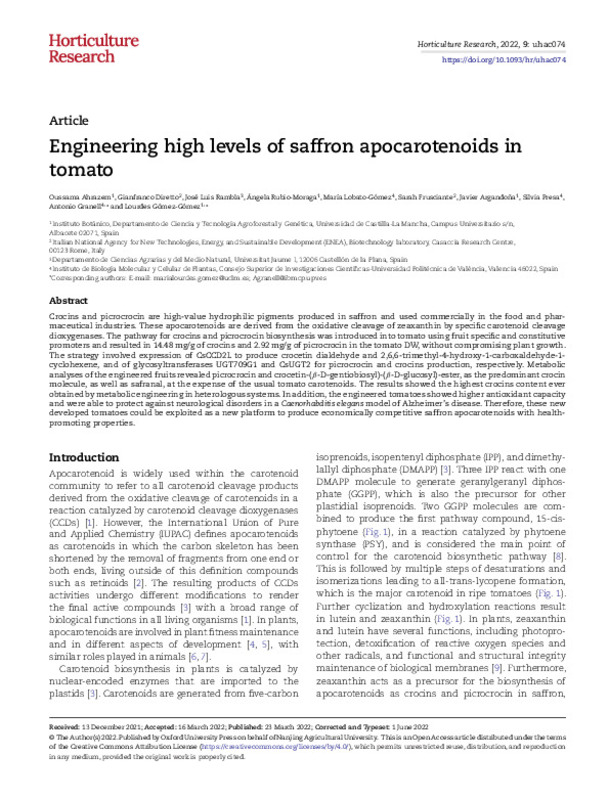JavaScript is disabled for your browser. Some features of this site may not work without it.
Buscar en RiuNet
Listar
Mi cuenta
Estadísticas
Ayuda RiuNet
Admin. UPV
Engineering high levels of saffron apocarotenoids in tomato
Mostrar el registro sencillo del ítem
Ficheros en el ítem
| dc.contributor.author | Ahrazem, Oussama
|
es_ES |
| dc.contributor.author | Diretto, Gianfranco
|
es_ES |
| dc.contributor.author | Rambla Nebot, Jose Luis
|
es_ES |
| dc.contributor.author | Rubio-Moraga, Ángela
|
es_ES |
| dc.contributor.author | Lobato-Gómez, María
|
es_ES |
| dc.contributor.author | Frusciante, Sarah
|
es_ES |
| dc.contributor.author | Argandoña, Javier
|
es_ES |
| dc.contributor.author | Presa Castro, Silvia
|
es_ES |
| dc.contributor.author | GRANELL RICHART, ANTONIO
|
es_ES |
| dc.contributor.author | Gómez-Gómez, Lourdes
|
es_ES |
| dc.date.accessioned | 2023-05-02T18:00:38Z | |
| dc.date.available | 2023-05-02T18:00:38Z | |
| dc.date.issued | 2022-01-05 | es_ES |
| dc.identifier.uri | http://hdl.handle.net/10251/193067 | |
| dc.description.abstract | [EN] Crocins and picrocrocin are high-value hydrophilic pigments produced in saffron and used commercially in the food and pharmaceutical industries. These apocarotenoids are derived from the oxidative cleavage of zeaxanthin by specific carotenoid cleavage dioxygenases. The pathway for crocins and picrocrocin biosynthesis was introduced into tomato using fruit specific and constitutive promoters and resulted in 14.48 mg/g of crocins and 2.92 mg/g of picrocrocin in the tomato DW, without compromising plant growth. The strategy involved expression of CsCCD2L to produce crocetin dialdehyde and 2,6,6-trimethyl-4-hydroxy-1-carboxaldehyde-1-cyclohexene, and of glycosyltransferases UGT709G1 and CsUGT2 for picrocrocin and crocins production, respectively. Metabolic analyses of the engineered fruits revealed picrocrocin and crocetin-(beta-D-gentiobiosyl)-(beta-D-glucosyl)-ester, as the predominant crocin molecule, as well as safranal, at the expense of the usual tomato carotenoids. The results showed the highest crocins content ever obtained by metabolic engineering in heterologous systems. In addition, the engineered tomatoes showed higher antioxidant capacity and were able to protect against neurological disorders in a Caenorhabditis elegans model of Alzheimer's disease. Therefore, these new developed tomatoes could be exploited as a new platform to produce economically competitive saffron apocarotenoids with health-promoting properties. | es_ES |
| dc.description.sponsorship | This work was supported by grants BIO2016-77000-R from the Spanish Ministerio de Ciencia, Innovacion y Uni-versidades and SBPLY/17/180501/000234 from the Junta de Comunidades de Castilla-La Mancha (co-financed European Union FEDER funds) and HARNESSTOM, contract number 101000716 Innovation Action ECH2020-SFS-2020-1. GD and LGG are participants of the European COST action CA15136 (EUROCAROTEN). GD and AG are participants of the European COST action CA18210 (ROXY). LGG is a participant of the CARNET network (BIO2015-71703-REDT and BIO2017-90877-RED). JLR was supported by the Spanish Ministry of Economy and Competitiveness through a "Juan de la CiervaFormacion" grant (FJCI-2016-28601). The UCLM and the IBMCP researchers constitute the Associated Unit of CAROTENOID BIOTECHNOLOGY. | es_ES |
| dc.language | Inglés | es_ES |
| dc.publisher | Springer Nature | es_ES |
| dc.relation.ispartof | Horticulture Research | es_ES |
| dc.rights | Reconocimiento (by) | es_ES |
| dc.title | Engineering high levels of saffron apocarotenoids in tomato | es_ES |
| dc.type | Artículo | es_ES |
| dc.identifier.doi | 10.1093/hr/uhac074 | es_ES |
| dc.relation.projectID | info:eu-repo/grantAgreement/EC/H2020/101000716/EU | es_ES |
| dc.relation.projectID | info:eu-repo/grantAgreement/JCCM//SBPLY%2F17%2F180501%2F000234/ | es_ES |
| dc.relation.projectID | info:eu-repo/grantAgreement/MINECO//BIO2015-71703-REDT/ES/CAROTENOIDES EN RED: DE LOS MICROORGANISMOS Y LAS PLANTAS A LOS ALIMENTOS Y LA SALUD/ | es_ES |
| dc.relation.projectID | info:eu-repo/grantAgreement/MINECO//BIO2016-77000-R/ | es_ES |
| dc.relation.projectID | info:eu-repo/grantAgreement/MINECO//BIO2017-90877-RED/ | es_ES |
| dc.relation.projectID | info:eu-repo/grantAgreement/MINECO//FJCI-2016-28601/ | es_ES |
| dc.relation.projectID | info:eu-repo/grantAgreement/COST//COST Action CA18210/ | es_ES |
| dc.rights.accessRights | Abierto | es_ES |
| dc.description.bibliographicCitation | Ahrazem, O.; Diretto, G.; Rambla Nebot, JL.; Rubio-Moraga, Á.; Lobato-Gómez, M.; Frusciante, S.; Argandoña, J.... (2022). Engineering high levels of saffron apocarotenoids in tomato. Horticulture Research. 9:1-13. https://doi.org/10.1093/hr/uhac074 | es_ES |
| dc.description.accrualMethod | S | es_ES |
| dc.relation.publisherversion | https://doi.org/10.1093/hr/uhac074 | es_ES |
| dc.description.upvformatpinicio | 1 | es_ES |
| dc.description.upvformatpfin | 13 | es_ES |
| dc.type.version | info:eu-repo/semantics/publishedVersion | es_ES |
| dc.description.volume | 9 | es_ES |
| dc.identifier.eissn | 2052-7276 | es_ES |
| dc.identifier.pmid | 35669709 | es_ES |
| dc.identifier.pmcid | PMC9157650 | es_ES |
| dc.relation.pasarela | S\486918 | es_ES |
| dc.contributor.funder | European Commission | es_ES |
| dc.contributor.funder | European Regional Development Fund | es_ES |
| dc.contributor.funder | Ministerio de Economía y Competitividad | es_ES |
| dc.contributor.funder | Junta de Comunidades de Castilla-La Mancha | es_ES |
| dc.contributor.funder | European Cooperation in Science and Technology | es_ES |








